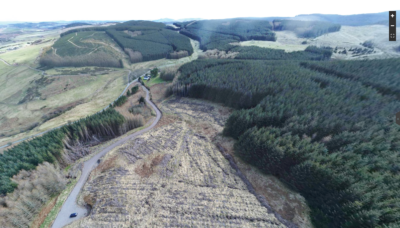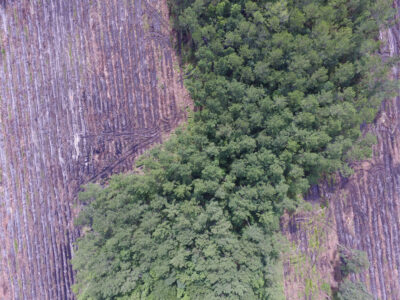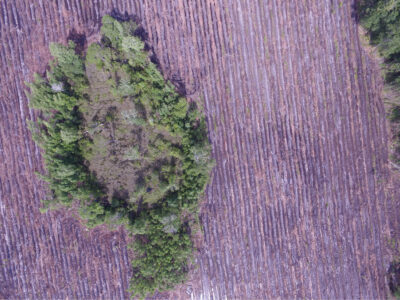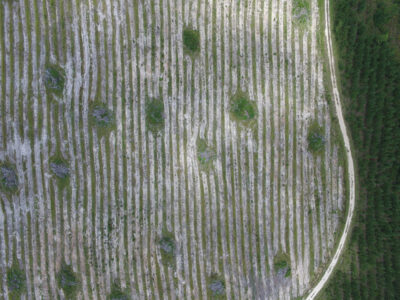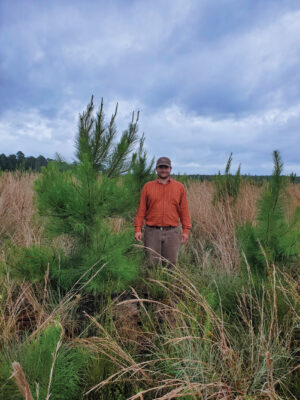The revolution of precision agriculture—with its drone-guided application of fertilizer and pesticides and continuous mapping and monitoring of crop needs—has arrived in the forest.
Just as farmers use mapping to optimize growing conditions, foresters can apply sophisticated tools to better plan and manage the forest.
F&W Forestry Services, for one, applies a geographic information system (GIS) approach to assess the health of clients’ forests and maximize lumber yield. F&W’s forest consultants are increasingly using drones to capture details to guide forest management plans, and simply to provide a top-down view of the forest.
“Landowners can see the quality of the work from the air,” said Bryan Croft, regional manager at F&W. “And they learn a little bit more about their property too.”
Farming rich forest land
F&W manages hundreds of thousands of acres of privately-owned yellow-pine plantations in southeast Georgia and northern Florida. Like modern farming, this is not a plant-and-watch operation: much can be done to improve the health and yield of each tree. The company undertakes considerable mechanical work, guided by maps, including: dragging a drum chopper behind a tractor to knock down brush; preparing seedling beds by mounding topsoil in rows; and spot raking to increase bed quality.

Drone imagery of forestry provides a foundation to give landowners detailed location intelligence on their harvests without performing costly and hazardous physical inventories.
Each of these tactics has been shown to improve yield, sometimes dramatically. One study from the 1970s1 showed a 76 percent increase in pine growth with a program of fertilizer and bedding. That impressive yield led to the quick spread of the practice. Yellow-pine forests have been farmed for the past 200 years in the region known as America’s wood basket, and it didn’t take long for tree-farming practices to spread. Many owners apply all these practices in their highly managed forests.
“We have some of the most productive soils in the southeast,” Croft said. “We can really grow trees fast.”
Pine plantation forests are planted with precision with special tractors that evenly space seedlings. Some are even hand-planted for further control and consistency. “All the bedding work is done with GPS, and the beds are very straight, very consistent,” Croft said.
The precision work is guided by maps that F&W creates. The maps contain details about soil type, vegetation health, and topography.
F&W also uses GIS to record all the services it applies to each forest tract. Drones provide owners with an added assurance that the work that was contracted has been done. “When you’re communicating with a forest owner 1,000 miles away, and you’re telling them, ‘Hey, it rained six inches yesterday, there’s water flowing down the road, and it’s too wet to work,’ it’s nice that you can fly up above and take a picture to show them,” Croft said.
Flexibility of flights
Drones provide other important capabilities that F&W consultants are just beginning to exploit.
“Using the drone to quickly take a couple of shots for our inspection reports has been an eye-opener for a lot of landowners,” Croft said. “In today’s real-time world, the quicker you can get information out that’s accurate, the better off you are.”
The flexibility and low cost of launching a drone, and the data drones can gather, is why they’ve become essential to field operations at F&W and elsewhere.
“We’re flying drones in the southeastern United States out to Arkansas, Texas, the northeast around New York and Vermont, and we’re flying a lot in the United Kingdom,” said Collier Kidd, a GIS and mapping specialist at F&W who also manages the drone program.
In June 2021 F&W had its busiest flying month with 119 flights, because it’s easiest to see forest health during the heaviest growing months of summer. Kidd estimates that they’ve flown more than 50,000 acres since the drone program began in earnest a few years ago. The drones provide imagery for site preparation work, maintenance, and readiness for planting season. They also help plan for harvest, which occurs year-round, depending on the market and the interest of the owner.
“Most landowners are growing timber to around age 20 to 25 years, before clear cutting and starting a new plantation,” Croft said. “We’re thinning timbers as early as age 8, and often do a second thinning after 16 to 18 years.”
F&W planted roughly 24,000 acres last year for clients in Croft’s region, which equates to roughly 38 square miles of new forest to meet the demand for lumber to build housing and other structures.
Making the most of drone mapping
Croft credits F&W’s growth to adding mapping and drone imaging capacity to its consulting services.
In its real-estate business, imagery and point clouds of a forest tract are often enough to convince a person to buy. “If you’ve got somebody interested in a property we have for sale in Virginia, but they live in Texas, you can save them a trip to look at the property. The imagery is that good,” Kidd said. He sees a future in using the drones for marketing materials and connecting with potential buyers.
Croft has hopes for more 3D viewing of the land and the trees and the ability to analyze how trees respond to treatments.
“I think there’s potential to jump into changes in leaf-area index after fertilization applications, and maybe even seeing changes in foliage color to forecast growth and yields,” Croft said. “The holy grail would be the ability to conduct an inventory without sending a forester.”
For Croft, the convenience of a drone to cover more ground and gather more input is probably the most important factor.
“On those days when you want to look at something off in the distance, and it’s either 100 degrees or it’s knee-deep in water, it’s a nice tool to have,” he said. “You can never really predict when those days will come, so it’s good to have it in the truck with you at all times.”
Learn more about how GIS helps maximize the value of timber assets2.
This article originally appeared on Esri Blog3.
Sidebar
A Drone Tool for Fleet Operators
Scott Noulis is a solution engineer on the Natural Resources team at Esri. He works with organizations in the petroleum, forestry, and renewables industries to incorporate location intelligence and GIS into solutions that address business challenges. His prior experience includes various roles as a GIS professional in the energy industry.
Collier Kidd, a GIS and mapping specialist at F&W Forestry Services, has been integrating Site Scan for ArcGIS4 to streamline data capture and flight planning for F&W’s growing fleet of drones.
The drone management solution used previously was inefficient; requiring too much of his time to manage the process and act as a middleman between all the pilots. He also had to process imagery and then upload and share it himself.
Now, the pilots have access to quickly upload and process what their drones captured. This comes in handy to ensure they captured what they came to collect.
It also means F&W can provide to owners quick feedback and answers that otherwise would have taken days or even a week.
Kidd also finds the tools he has as an administrator very useful. He can review the work of the pilots, and keep track of their licenses and Federal Aviation Administration (FAA) registration. He can see and manage battery use and remind pilots if their certification is set to expire soon.
With the drones, the operators cover more ground, and can do that safely as they don’t have to walk through hazardous terrain to inventory the forest.
“Ultimately, the goal is to get everybody in our company flying drones and realizing all the advantages of it,” Kidd said.
1 fs.usda.gov/treesearch/pubs/42891
2 esri.com/en-us/industries/natural-resources/segments/forestry
3 esri.com/about/newsroom/blog/
4 esri.com/en-us/arcgis/products/site-scan-for-arcgis/overview
